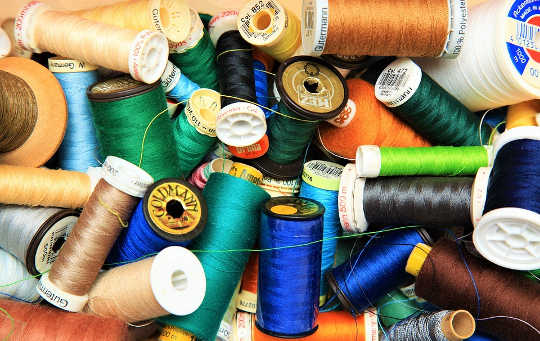
Photo Credit: Max Pixel. (CC 0)
Whether we’re talking about clutter that’s physical, paper, electronic, or mental, its defining characteristic is that it’s stuck. You can tell it’s clutter because there’s no movement, no progress, and no life — it’s just the same old story over and over again.
If you have a lot of stuff but it’s in movement — for instance, you actually wear all of those clothes or use all that kitchen equipment, or the piles of paper on your desk are being handled, worked on, and pruned each day — then that’s not clutter. That’s just having a lot of stuff. Which is fine. You’re allowed to have all the stuff you want.
Much of the advice about getting rid of clutter seems to start with the cheerfully abrupt command to “Just do it!” But when you can’t identify the underlying beliefs that are causing you to become buried in clutter, that’s almost impossible. So I’ve listed a few of the root causes of clutter that rarely get discussed and a few tough-love strategies to initiate change.
1. Nostalgia.
You love the memory. You love the person who gave it to you. You love the size you were when you bought it. None of these is a good reason to hang on to something you’re not using.
Savor the emotion, make some 5-Minute Art about it, take a picture of it, and let it go. The 5-Minute Art concept is one of the most flat-out useful ideas in this book, so let’s talk about it now.
Here’s the plan: The next time you feel upset, sad, frustrated, furious, or trapped by the past, take five minutes and make some art about how you are feeling. Draw a picture, write a poem, do a little dance, sing a little song. This art does not have to be good. In fact, I think it’s better if you make it deliberately bad, and you have permission to throw it away as soon as you’re done. Why am I suggesting that you make some bad, disposable art? Because feelings just want to be felt.
Feelings just want to be felt.
Once a feeling knows that it’s been felt, the energy of it is released and can transform into a different feeling. You’ve had that experience — when a good cry is followed by a feeling of deep peace, or when an angry outburst transmogrifies into a fit of the giggles. On the other hand, when you keep your feelings locked away, they often grow stronger, darker, and more powerful. Worse yet, whatever steps you take to avoid your feelings will end up sabotaging you. So making some 5-Minute Art is a quick, easy, and even delightful way to activate the pressure- release valve.
Externalizing your feelings also gives you a new perspective on them. Using color, rhythm, images, and melody to give form to your emotions allows you to understand them in a new way. And it can allow others to better understand you as well.
2. Your fantasy about your future life.
“Someday...” Yes, maybe someday. But not now. You don’t yet have a mountain cabin to decorate, so the moose head can go. You don’t yet have the sailboat, so the plastic tumblers with the cute anchors on them can go. You don’t have the time right now to turn that pile of old T-shirts into a quilt, so they can probably go, too.
And if all this rough talk is causing you pangs, that is excellent news. Those pangs mean that you really want that fantasy future to come true. So then take a step toward that today. Start a penny jar for the down-payment on the cabin, book an afternoon sail for this weekend, or start cutting the quilt squares this evening.
3. Future scarcity.
“I might need this sometime.” Yes, you might. In which case you can go get another one then. I think this belief is actually a form of perfectionism in disguise: we perfectionists feel we must be prepared for every eventuality. This is an understandable and admirable goal but still no reason to hang on to something that’s just taking up space.
Also, if you are going to let an imaginary future make your decisions for you, why not imagine a future in which not hanging on to whatever it is turns out to be the best possible decision?
4. Loyalty.
There are few things more pleasing to a human person than the feeling of being in the right, and few things less pleasing than the feeling of being in the wrong. Sometimes you don’t want to get rid of clutter because it feels like admitting you made a mistake in buying this thing, that you misjudged. You want to believe in your past decisions, so you keep recommitting to those decisions long after they’ve been proved erroneous.
For example, you thought the yellow curtains would look great in the guest room, but they don’t, so you’ve never put them up. And now every time you see them in the bottom of the linen cupboard, you think, “I really thought those would look nice, but they don’t.” And then, to keep from feeling as though you miscalculated, you think, “Maybe they’ll look nice somewhere else someday.”
My mentor David Neagle did me a big favor when he taught me Leland Val Van de Wall’s quote, “The amount of success you achieve will be in direct proportion to the amount of truth you can accept about yourself without running away.” The ability to calmly accept that sometimes you blunder will hasten your spiritual maturity and probably improve your decorating skills.
5. Anthropomorphizing.
As a child, I believed that things had feelings. I remember giving extra good-night kisses to my stuffed Dumbo when he was new, because he had missed out on all the kisses I had given my other beloved wubbies over the years, and I wanted him to catch up. (Wubbies is my family’s word for all baby blankets, teddy bears, or special cuddle toys that a child loves especially and refuses to sleep without.)
Well, I still believe that things have feelings. I thank my car for its faithful service, I express gratitude to English muffins for being so delicious, and I usually say goodbye to the house as I leave it, even if I’m just dashing out to run errands. I was recently near tears at the thought of replacing some old dish towels, because I felt it was disrespectful to all their years of hard work.
If you’re feeling simpatico, then try making some 5-Minute Art about the thing. Then, say thank you to the thing and ask someone else to get rid of it for you. Just because you’re willing to say goodbye doesn’t mean you have to be the one to deliver it to the thrift store or, worse yet, the dumpster.
6. Replaying old tapes.
Worry is mental clutter. So is repetitive self-criticism. Any other thoughts that never lead to an outcome or a new thought are just taking up space in your head. It’s important to your continued growth to distinguish between actual thinking and those old tapes.
Whenever you catch yourself running old tapes, clap your hands loudly, or start to sing an uplifting song out load. Perhaps you can imagine the old thought falling deep into the earth where it can be composted.
You can also interrupt your own pattern by yelling out an unusual phrase like, “Peeny-Weenie Woo-Woos!” and then force yourself to think of something else. (A Peeny-Weenie Woo-Woo is a fairly horrible cocktail that has achieved legendary status in my family, as its effects caused several of the normally quite reserved adults to get down on the floor and leg wrestle.)
7. The law of diminishing returns.
The first one was great, and the second one was even better. But now you’re on your fifth, and the thrill is wearing off. Whether we’re talking about collectibles, books about space exploration, or red cashmere sweaters, take a look at the redundancies in your life, and see if there are a few items in the collection that can go.
When you are an expert on something, you tend to see minute variations as highly significant. Luke, a musician, composer, and teacher who is, at this writing, getting a PhD in music theory, informs me that his Telecaster and his short-scale Telecaster are completely different guitars, although I cannot really tell them apart. But he’s the expert, and he really does play them both.
By the same token, I have six varieties of black high-heeled shoes in my closet, and they each serve a very different purpose. If you are enough of a shoe-lover to actually be using all your black high-heeled shoes, then that’s not clutter — that’s just having good taste. But if you are only using one or two, you can probably afford to let the rest of the throng go.
LITTLE CHANGES ACTION STEP:
Get rid of something. Anything. Right now.
©2016 by Samantha Bennett. All Rights Reserved.
Reprinted with permission of New World Library, Novato, CA.
www.newworldlibrary.com or 800-972-6657 ext. 52.
Article Source:
 Start Right Where You Are: How Little Changes Can Make a Big Difference for Overwhelmed Procrastinators, Frustrated Overachievers, and Recovering Perfectionists
Start Right Where You Are: How Little Changes Can Make a Big Difference for Overwhelmed Procrastinators, Frustrated Overachievers, and Recovering Perfectionists
by Sam Bennett.
Click here for more info and/or to order this book.
About the Author
 Sam Bennett is the creator of the Organized Artist Company. In addition to her multifaceted writing and performance work, she specializes in personal branding, career strategies, and small-business marketing. She grew up in Chicago and now lives in a tiny beach town outside Los Angeles. Sam offers her revolutionary Get It Done Workshops, teleclasses, public speaking engagements and private consulting to overwhelmed procrastinators, frustrated overachievers and recovering perfectionists everywhere.
Sam Bennett is the creator of the Organized Artist Company. In addition to her multifaceted writing and performance work, she specializes in personal branding, career strategies, and small-business marketing. She grew up in Chicago and now lives in a tiny beach town outside Los Angeles. Sam offers her revolutionary Get It Done Workshops, teleclasses, public speaking engagements and private consulting to overwhelmed procrastinators, frustrated overachievers and recovering perfectionists everywhere.
Watch a video with Sam Bennett: Get It Done Mini-Workshop: Investing in Yourself
Watch an interview: How To Get Things Done in 15 Minutes a Day
Related Books
at InnerSelf Market and Amazon




























